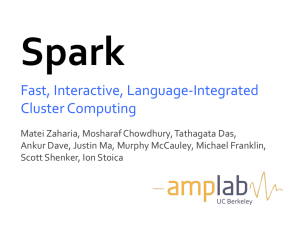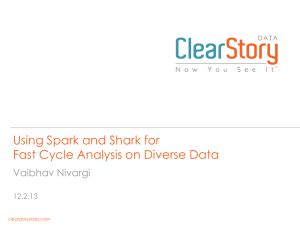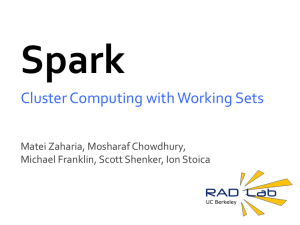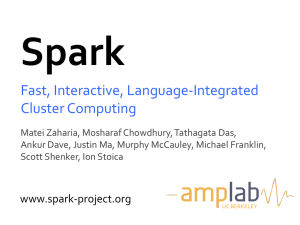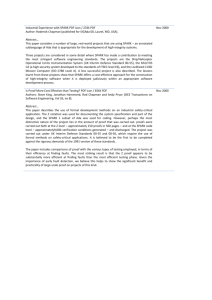spark_scala_days_2012 - University of California, Berkeley
advertisement
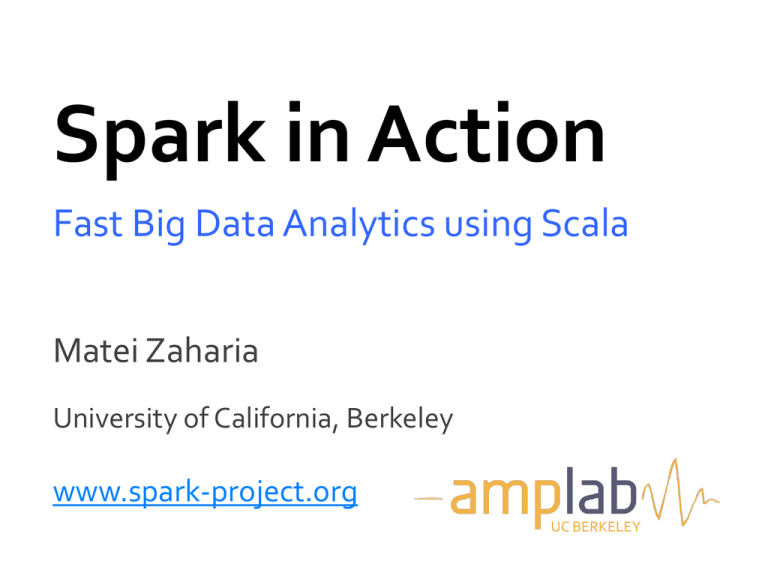
Spark in Action
Fast Big Data Analytics using Scala
Matei Zaharia
University of California, Berkeley
www.spark-project.org
UC BERKELEY
My Background
Grad student in the AMP Lab at UC Berkeley
» 50-person lab focusing on big data
Committer on Apache Hadoop
Started Spark in 2009 to provide a richer,
Hadoop-compatible computing engine
Spark Goals
Extend the MapReduce model to support more
types of applications efficiently
» Spark can run 40x faster than Hadoop for iterative
and interactive applications
Make jobs easier to program
»Language-integrated API in Scala
»Interactive use from Scala interpreter
Why go Beyond MapReduce?
MapReduce simplified big data analysis by giving
a reliable programming model for large clusters
But as soon as it got popular, users wanted more:
» More complex, multi-stage applications
» More interactive ad-hoc queries
Why go Beyond MapReduce?
Complex jobs and interactive queries both need
one thing that MapReduce lacks:
Efficient primitives for data sharing
Stage 3
Stage 2
Stage 1
Query 1
Query 2
Query 3
Iterative algorithm
Interactive data mining
Why go Beyond MapReduce?
Complex jobs and interactive queries both need
one thing that MapReduce lacks:
Efficient primitives for data sharing
Stage 3
Stage 2
Stage 1
Query 1
In MapReduce, the only way to shareQuery
data2 across
jobs is stable storage (e.g. HDFS) Query
-> slow!
3
Iterative algorithm
Interactive data mining
Examples
HDFS
read
HDFS
write
HDFS
read
iter. 1
HDFS
write
. . .
iter. 2
Input
HDFS
read
Input
query 1
result 1
query 2
result 2
query 3
result 3
. . .
I/O and serialization can take 90% of the time
Goal: In-Memory Data Sharing
iter. 1
iter. 2
Input
query 1
one-time
processing
Input
Distributed
memory
query 2
query 3
. . .
10-100× faster than network and disk
. . .
Solution: Resilient
Distributed Datasets (RDDs)
Distributed collections of objects that can be
stored in memory for fast reuse
Automatically recover lost data on failure
Support a wide range of applications
Outline
Spark programming model
User applications
Implementation
Demo
What’s next
Programming Model
Resilient distributed datasets (RDDs)
» Immutable, partitioned collections of objects
» Can be cached in memory for efficient reuse
Transformations (e.g. map, filter, groupBy, join)
» Build RDDs from other RDDs
Actions (e.g. count, collect, save)
» Return a result or write it to storage
Example: Log Mining
Load error messages from a log into memory, then
interactively search for various patterns
lines = spark.textFile(“hdfs://...”)
BaseTransformed
RDD
RDD
results
errors = lines.filter(_.startsWith(“ERROR”))
messages = errors.map(_.split(‘\t’)(2))
cachedMsgs = messages.cache()
tasks
Driver
Cache 1
Worker
Block 1
Action
cachedMsgs.filter(_.contains(“foo”)).count
Cache 2
cachedMsgs.filter(_.contains(“bar”)).count
Worker
. . .
Cache 3
Result: scaled
full-text
tosearch
1 TB data
of Wikipedia
in 5-7 sec
in <1(vs
sec170
(vssec
20 for
secon-disk
for on-disk
data)
data)
Worker
Block 3
Block 2
RDD Fault Tolerance
RDDs track the series of transformations used to
build them (their lineage) to recompute lost data
E.g: messages
= textFile(...).filter(_.contains(“error”))
.map(_.split(‘\t’)(2))
HadoopRDD
FilteredRDD
MappedRDD
path = hdfs://…
func = _.contains(...)
func = _.split(…)
Example: Logistic Regression
Goal: find best line separating two sets of points
random initial line
target
Example: Logistic Regression
val data = spark.textFile(...).map(readPoint).cache()
var w = Vector.random(D)
for (i <- 1 to ITERATIONS) {
val gradient = data.map(p =>
(1 / (1 + exp(-p.y*(w dot p.x))) - 1) * p.y * p.x
).reduce(_ + _)
w -= gradient
}
println("Final w: " + w)
Running Time (s)
Logistic Regression Performance
4000
3500
3000
2500
2000
1500
1000
500
0
110 s / iteration
Hadoop
Spark
1
5
10
20
Number of Iterations
30
first iteration 80 s
further iterations 6 s
Spark Users
User Applications
In-memory analytics on Hive data (Conviva)
Interactive queries on data streams (Quantifind)
Exploratory log analysis (Foursquare)
Traffic estimation w/ GPS data (Mobile Millennium)
Algorithms for DNA sequence analysis (SNAP)
...
Conviva GeoReport
Hive
20
Spark
0.5
Time (hours)
0
5
10
15
20
Group aggregations on many keys with the same
WHERE clause
40× gain over Apache Hive comes from
avoiding repeated reading, deserialization and
filtering
Quantifind Stream Analysis
Data Feeds
Parsed
Documents
Extracted
Entities
Relevant
Time Series
Insights
Load new documents every few minutes
Compute an in-memory table of time series
Let users query interactively via web app
Implementation
Runs on Apache Mesos cluster
manager to coexist w/
Hadoop
Spark Hadoop
Node
Supports any Hadoop storage
system (HDFS, HBase, …)
Easy local mode and EC2 launch scripts
No changes to Scala
MPI
…
Mesos
Node
Node
Task Scheduler
Runs general DAGs
Pipelines functions
within a stage
Cache-aware data
reuse & locality
Partitioning-aware
to avoid shuffles
B:
A:
G:
Stage 1
C:
groupBy
D:
F:
map
E:
Stage 2
join
union
= cached data partition
Stage 3
Language Integration
Scala closures are Serializable Java objects
» Serialize on master, load & run on workers
Not quite enough
» Nested closures may reference entire outer scope,
pulling in non-Serializable variables not used inside
» Solution: bytecode analysis + reflection
Interpreter integration
» Some magic tracks variables, defs, etc that each line
depends on and automatically ships them to workers
Demo
What’s Next?
Hive on Spark (Shark)
Compatible port of the SQL-on-Hadoop engine
that can run 40x faster on existing Hive data
Scala UDFs for statistics and machine learning
Alpha coming really soon
Streaming Spark
Extend Spark to perform streaming computations
Run as a series of small (~1 s) batch jobs, keeping
state in memory as fault-tolerant RDDs
Alpha expected by June
map
tweetStream
.flatMap(_.toLower.split)
.map(word => (word, 1))
.reduceByWindow(5, _ + _)
reduceByWindow
T=1
T=2
…
Conclusion
Spark offers a simple, efficient and powerful
programming model for a wide range of apps
Shark and Spark Streaming coming soon
Download and docs: www.spark-project.org
@matei_zaharia / matei@berkeley.edu
Related Work
DryadLINQ
» Build queries through language-integrated SQL
operations on lazy datasets
» Cannot have a dataset persist across queries
Relational databases
» Lineage/provenance, logical logging, materialized views
Piccolo
» Parallel programs with shared distributed hash tables;
similar to distributed shared memory
Iterative MapReduce (Twister and HaLoop)
» Cannot define multiple distributed datasets, run different
map/reduce pairs on them, or query data interactively
Related Work
Distributed shared memory (DSM)
» Very general model allowing random reads/writes, but hard
to implement efficiently (needs logging or checkpointing)
RAMCloud
» In-memory storage system for web applications
» Allows random reads/writes and uses logging like DSM
Nectar
» Caching system for DryadLINQ programs that can reuse
intermediate results across jobs
» Does not provide caching in memory, explicit support over
which data is cached, or control over partitioning
SMR (functional Scala API for Hadoop)
Behavior with Not Enough RAM
60
11.5
40
29.7
40.7
58.1
80
68.8
Iteration time (s)
100
20
0
Cache
disabled
25%
50%
75%
% of working set in cache
Fully
cached
